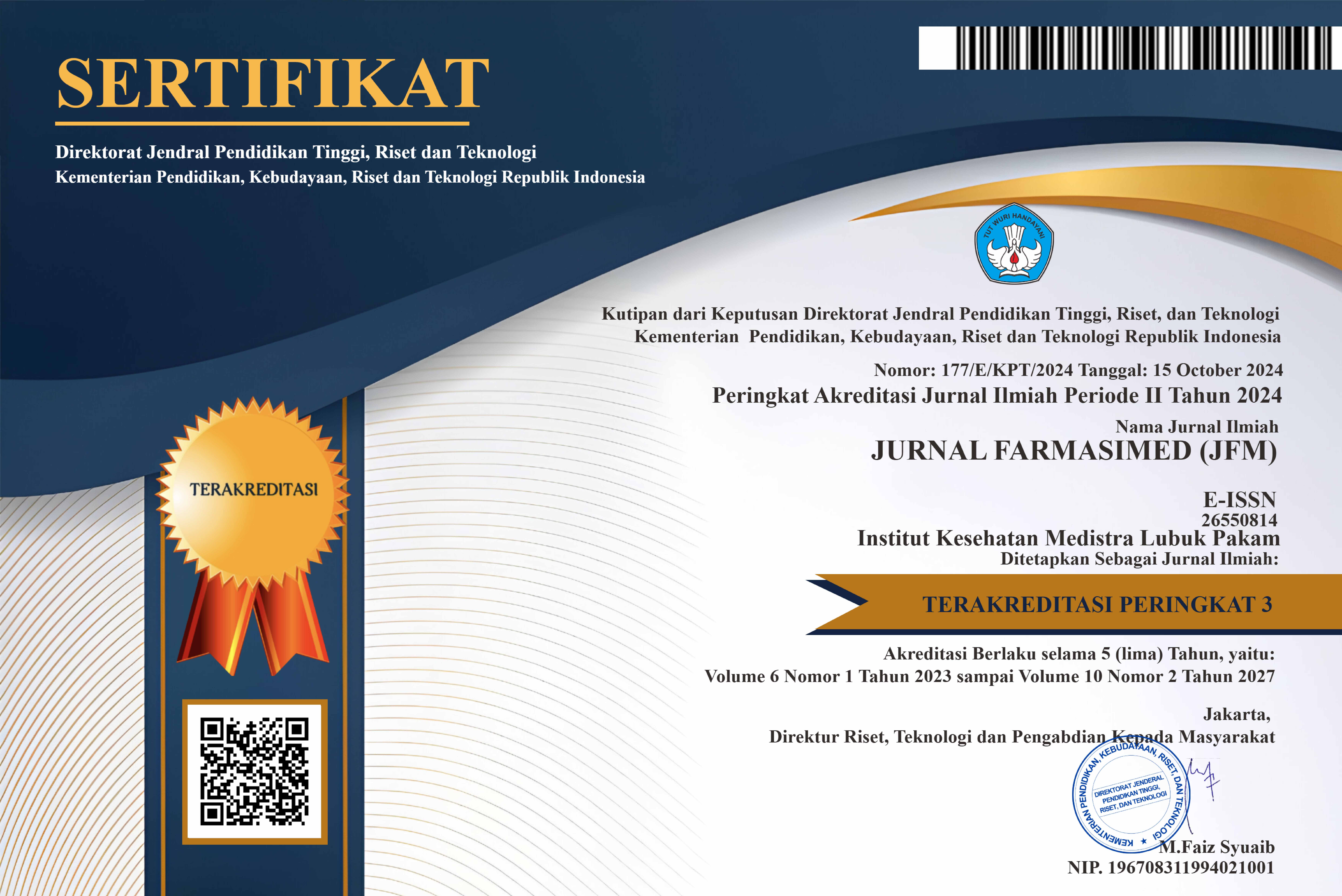THE EFFECT OF SUGARCANE LEAF EXTRACT ON MALONDIALDEHYDE PLASMA LEVELS IN CARBON TETRACHLORIDE-INDUCED RATS
DOI:
https://doi.org/10.35451/jfm.v5i1.1340Keywords:
karbon tetraklorida, daun tebu, malondialdehid, tikusAbstract
Peroksidasi lipid akibat radikal bebas dapat menyebabkan kematian sel yang dapat merusak berbagai organ, termasuk liver. Hal ini dapat ditandai dengan peningkatan kadar malondialdehid. Pengukuran parameter ini pada darah dan organ digunakan sebagai penanda adanya stres oksidatif. Radikal bebas akibat peroksidasi lipid dapat diredam dengan senyawa antioksidan. Beberapa penelitian telah membuktikan aktivitas antioksidan tebu (Saccharum officinarum). Daun tebu dan jus tebu dari varietas yang berbeda-beda telah menunjukkan sifat antioksidan yang baik. Penelitian ini dilakukan untuk mengetahui efek ekstrak etanol tebu dengan berbagai dosis terhadap kadar malondialdehid plasma tikus yang diinduksi stress oksidatif dengan karbon tetraklorida (CCl4). Daun tebu diekstraksi dengan maserasi dengan pelarut etanol 96%. Pembuatan kurva baku malondialdehid dilakukan dengan seri larutan 1,1,2,2-tetraethoxypropane. Pengujian dilakukan terhadap hewan uji tikus Wistar yang dibagi menjadi beberapa kelompok. Pembagian kelompok meliputi kelompok normal tanpa induksi CCl4 diberikan CMC-Na 1%; kontrol negatif diberikan CMC-Na 1%; kontrol positif diberikan Silybum marinum yang 100 mg/kgBB; kelompok dosis yang terdiri atas 300, 400, dan 500 yang masing-masing diberikan ekstrak etanol daun tebu dosis dengan dosis 300 mg/kgBB, 400 mg/kgBB dan 500 mg/kgBB berturut-turut. Tikus diperlakukan sepanjang 14 hari lalu diambil sampel plasmanya pada hari ke-15 untuk pengukuran kadar malondialdehid. Hasil ekstraksi daun tebu mendapatkan rendemen sebesar 16,05%. Kurva baku yang digunakan untuk mengukur malondialdehid plasma tikus adalah y = 0,0059x + 0,0238. Hasil menunjukkan pemberian ekstrak daun tebu semua dosis memiliki nilai malondialdehid yang lebih rendah dibandingkan kontrol negatif. Dosis 400 mg/kgBB tidak memiliki perbedaan signifikan dengan kontrol positif, sedangkan dosis 500 mg/kgBB lebih rendah dibanding dengan kontrol positif. Hal ini diduga karena metabolit sekunder seperti flavon yang terdapat pada ekstrak yang dapat meredam radikal bebas. Ekstrak etanol daun tebu dapat berperan sebagai antioksidan dengan menurunkan kadar malondialdehid darah tikus terinduksi CCl4.
Downloads
References
Abbas, S. R., Sabir, S. M., Ahmad, S. D., Boligon, A. A., & Athayde, M. L. (2014). Phenolic profile, antioxidant potential and DNA damage protecting activity of sugarcane (Saccharum officinarum). Food Chemistry, 147, 10–16. https://doi.org/10.1016/j.foodchem.2013.09.113
Ali, S. E., El Gedaily, R. A., Mocan, A., Farag, M. A., & El-Seedi, H. R. (2019). Profiling metabolites and biological activities of sugarcane (Saccharum officinarum linn.) juice and its product molasses via a multiplex metabolomics approach. Molecules, 24(934), 1–21. https://doi.org/10.3390/molecules24050934
Arora, R., Vig, A. P., & Arora, S. (2013). Lipid Peroxidation : A Possible Marker for Diabetes. J Diabetes Metab S11:, S11(007). https://doi.org/10.4172/2155-6156.S11-007
Azmir.J, Zaidul.I.S.M, Rahman.M.M, Sharif.K.M, Mohamed. A, F. Sahena, (2013). Techniques for extraction of bioactive compounds from plant materials: A review. Journal of Food Engineering, 117, 426–436.
Azwanida, N. (2015). A Review on the Extraction Methods Use in Medicinal Plants, Principle, Strength and Limitation. Medicinal & Aromatic Plants, 04(03), 3–8. https://doi.org/10.4172/2167-0412.1000196
Chiu, Y. J., Chou, S. C., Chiu, C. S., Kao, C. P., Wu, K. C., Chen, C. J., … Peng, W. H. (2018). Hepatoprotective effect of the ethanol extract of Polygonum orientale on carbon tetrachloride-induced acute liver injury in mice. Journal of Food and Drug Analysis, 26(1), 369–379. https://doi.org/10.1016/j.jfda.2017.04.007
Coutinho, I. D., Baker, J. M., Ward, J. L., Beale, M. H., Creste, S., & Cavalheiro, A. J. (2016). Metabolite profiling of sugarcane genotypes and identification of flavonoid glycosides and phenolic acids. Journal of Agricultural and Food Chemistry, 64(21), 4198–4206. https://doi.org/10.1021/acs.jafc.6b01210
Dewi, I. P., Kwintana, R. B., Ulinnuha, J. U., Rachman, F., Christianty, F. M., & Holidah, D. (2021). Hepatoprotective effect of ethanolic extract of sugarcane (Saccharum officinarum Linn) leaves. J Basic Clin Physiol Pharmacol, 32(4), 533–540.
Domitrović, R., & Potočnjak, I. (2015). A comprehensive overview of hepatoprotective natural compounds: mechanism of action and clinical perspectives. Archives of Toxicology (Vol. 90). https://doi.org/10.1007/s00204-015-1580-z
Fujimoto, J., & Iimuro, Y. (2010). Carbon Tetrachloride-Induced Hepatotoxicity. In Comprehensive Toxicology, Second Edition (2nd ed., Vol. 9, pp. 437–455). Oxford: Elsevier. https://doi.org/10.1016/B978-0-08-046884-6.01018-6
Grotto, D., Maria, L. S., Valentini, J., Paniz, C., Schmitt, G., & Garcia, C. (2009). Importance of The Lipid Peroxidation Biomarkers and Methodological Aspects For Malondialdehyde Quantification. Quim Nova, 32(1), 169–174.
Itoh, A., Isoda, K., Kondoh, M., Kawase, M., Watari, A., Kobayashi, M., Yagi, K. (2010). Hepatoprotective Effect of Syringic Acid and Vanillic Acid on CCl4-Induced Liver Injury. Biological and Pharmaceutical Bulletin, 33(June), 983–987.
Khan, S. W., Ghafoor, A., & Ahamd, N. (2018). Hepatoprotective Properties of Sugarcane Juice and Vitamin C were compared in a Mouse Model of Liver Injury Induced by INH ( Isoniazid ). PJMHS, 12(2), 764–767.
Lee, C. P., Chen, Z. T., Yu, P. Y., Yen, W. J., Lin, K. M., & Duh, P. Der. (2013). Comparison of protective effects of three varieties of sugarcane leaves on oxidative stress in Clone 9 cells. Journal of Functional Foods, 5(2), 878–887. https://doi.org/10.1016/j.jff.2013.01.037
López-lázaro, M. (2009). Distribution and Biological Activities of the Flavonoid Luteolin. Mini-Reviews in Medicinal Chemistry, 9(1), 31–59.
Panjaitan, R. G., Handharyani, E., Chairul, Masriani, Zakiah, Z., & Manalu, W. (2007). The Effect of Carbon Tetrachloride Administration on Liver and Renal Function. Makara Kesehatan, 11(1), 11–16.
Su, L., Zhang, J., Gomez, H., Murugan, R., Hong, X., Xu, D., Peng, Z. (2019). Review Article Reactive Oxygen Species-Induced Lipid Peroxidation in Apoptosis , Autophagy , and Ferroptosis. Oxidative Medicine and Cellular Longevity, 2019.
Tristanti, I., Fatimawali, & Widdhi, B. (2013). Uji efek hepatoprotektor ekstrak etanol daun benalu langsat ( Dendrophthoe petandra ( l .) miq .) terhadap kadar malondialdehid ( mda ) pada hati tikus putih jantan galur wistar yang diinduksi karbon tetraklorida ( CCl 4 ). Pharmacon, 2(03), 75–78.
Vargas-Mendoza, N., Madrigal-Santillán, E., Morales-González, Á., Esquivel-Soto, J., Esquivel-Chirino, C., García-Luna y González-Rubio, M. G., Morales-González, J. A. (2014). Hepatoprotective effect of silymarin. World Journal of Hepatology, 6(3), 144–149. https://doi.org/10.4254/wjh.v6.i3.144
Vila, F. C., Colombo, R., De Lira, T. O., & Yariwake, J. H. (2008). HPLC microfractionation of flavones and antioxidant (radical scavenging) activity of Saccharum officinarum L. Journal of the Brazilian Chemical Society, 19(5), 903–908. https://doi.org/10.1590/S0103-50532008000500014
Woolbright, B. J., & Jaeschke, H. (2018). Mechanisms of Inflammatory Liver Injury and Drug-Induced Hepatotoxicity. Current Pharmacology Reports, 4(5), 346–357. https://doi.org/10.1097/00024382-200403001-00333
Downloads
Published
Issue
Section
License
Copyright in each article is the property of the Author.

























